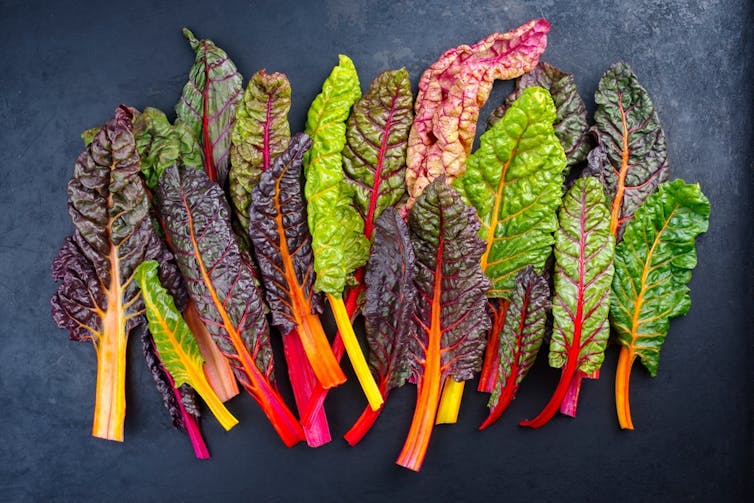
Leafy greens: Eight super-healthy one’s and why you should eat them
A nutritionist breaks down the health-giving benefits of various salad leaves.

Leafy greens are a great way to improve your health as they possess many vital nutrients, vitamins, minerals and antioxidants. As a nutritionist, I would highly recommend getting more of the following salad leaves in your diet.
Spinach
Spinach is easy to get all year round, and is chock full of iron, calcium, potassium and vitamins B6, C and K. It is also a good source of antioxidants, which can reduce the risk of many diseases, including heart disease and certain cancers.
It’s best eaten uncooked, as part of a salad, as cooking tends to destroy the naturally occurring polyphenols and flavanols in the leaves. Certain polyphenols and flavonoids may reduce the chance of developing certain cancers, cardiovascular diseases, diabetes and neurodegenerative diseases, such as Alzheimer’s disease.
Kale
Kale has a unique taste that can vary somewhat depending on its variety and how it’s prepared. If you can handle bitter taste, kale is packed with important micronutrients such as calcium, iron, magnesium, phosphorus, potassium, zinc, copper, manganese and selenium. It is also a good source of vitamins, including vitamins A, B, E, C and K.
Avoid blanching and boiling kale as it can reduce the amount of water-soluble minerals, vitamins and phytochemicals in the leaves. Kale can be eaten uncooked in salads.
A cup of uncooked kale (21g) is just nine calories.
Swiss chard
My third choice is Swiss chard, which has a slightly sweet flavour, and has good amounts of vitamins A and C. And even a small amount of Swiss chard (around 175 grams) can fulfil your daily requirement of vitamin K – which is important for blood clotting and healthy bones.
Swiss chard, which comes in a variety of colours, also has essential minerals such as iron, copper, potassium and calcium.

Collard greens
Collard greens are a good source of lutein, which is important for eye health. They are full of vitamins A and C and minerals such as calcium, iron, zinc, copper and selenium, and are a good source of fibre. As with spinach, you can get this all year round.
Rocket
If you’re in the mood for a leafy green with a fresh, tangy, slightly bitter and peppery taste, consider adding rocket to your plate. It’s been consumed by humans since at least Roman times, and is a popular topping on pizzas.
Rocket, also known as arugula and eruca, is packed with nitrates – which studies have shown can boost performance in sports. Rocket is also rich in vitamins K and C, and calcium and polyphenols.
Romaine lettuce
The crunchy and mild-tasting romaine lettuce is full of nutrient-rich goodies. It is a good source of vitamins and minerals, including vitamins A, K, C and folate (a B vitamin that is especially important during pregnancy). These nutrients are essential for maintaining overall health and supporting a healthy immune system.
Romaine, also known as cos lettuce, is a source of fibre too, which is known to reduce your risk of heart disease, stroke, type 2 diabetes and bowel cancer.
Watercress
If you enjoy a bit of spice and want to incorporate a leafy green with a distinct flavour into your meals, watercress is a great choice. It not only adds a burst of taste but also provides a rich source of vitamins A and C and antioxidants. Research suggests that watercress could be a therapeutic agent in oral cancer.
Bok choy
If you’re looking for a leafy green with a gentle flavour and satisfying texture, bok choy is a great choice. This variety of Chinese white cabbage can be used in stir-fries, soups, salads or simply sautéed as a side dish.
ALSO READ: Bruce Willis’ daughter shares update on the actor’s health
It is rich in fibre as well as various vitamins, minerals and antioxidants. This leafy green can help maintain bone health, immunity, vision, heart health, blood pressure and possibly prevent certain types of cancer.
I prefer to have a balanced diet and adding these leafy greens can help me stay healthy, improve my immunity, and reduce the risk of various chronic diseases. They are also low in calories, making them a good choice for those who want to manage their weight. So enjoy them in salads, smoothies, soups or as a side dish with your favourite meals.
Swrajit Sarkar, Senior Lecturer in Nutrition, City, University of London
This article is republished from The Conversation under a Creative Commons license. Read the original article.
